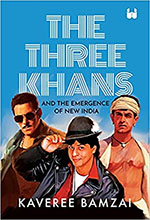Ramachandra Guha is one of the few historians to have considered with any degree of seriousness the role of the Hindi film in keeping the chaotic diversity of India together. Kaveree Bamzai’s engaging book under review extends Guha’s basic premise by examining the making of a shared cultural space, even as it traces compellingly the journey of the three Khans through the Hindi film industry and a globalizing India. Not only do Hindi films create a shared vocabulary of visual aesthetics, music and aspirations, she demonstrates, but their evolving ideas of heroism are embodied in the person of the male protagonist who seems to give form to the deepest desires of a given generation. Bamzai focuses on these embodiments of the hero as they change through the decades of Independent India’s history in the wake of generational shifts in the larger space of the political economy of the nation.
These are onerous matters, but the author’s touch is light. Bamzai employs scholarly studies on subjects of politics, economy and culture, yet wary of weighing down the writing, she keeps these at a nodding distance. For instance, Guha’s India After Gandhi (2007) cited above is one of the many studies which figure in the endnotes of chapters. Deftly marshalling her resources, Bamzai negotiates the complex political terrain of recent history: from the 80s to the present, foregrounding the three Khans as they emerge from these times and go on to redefine stardom, each in his own unique fashion.

